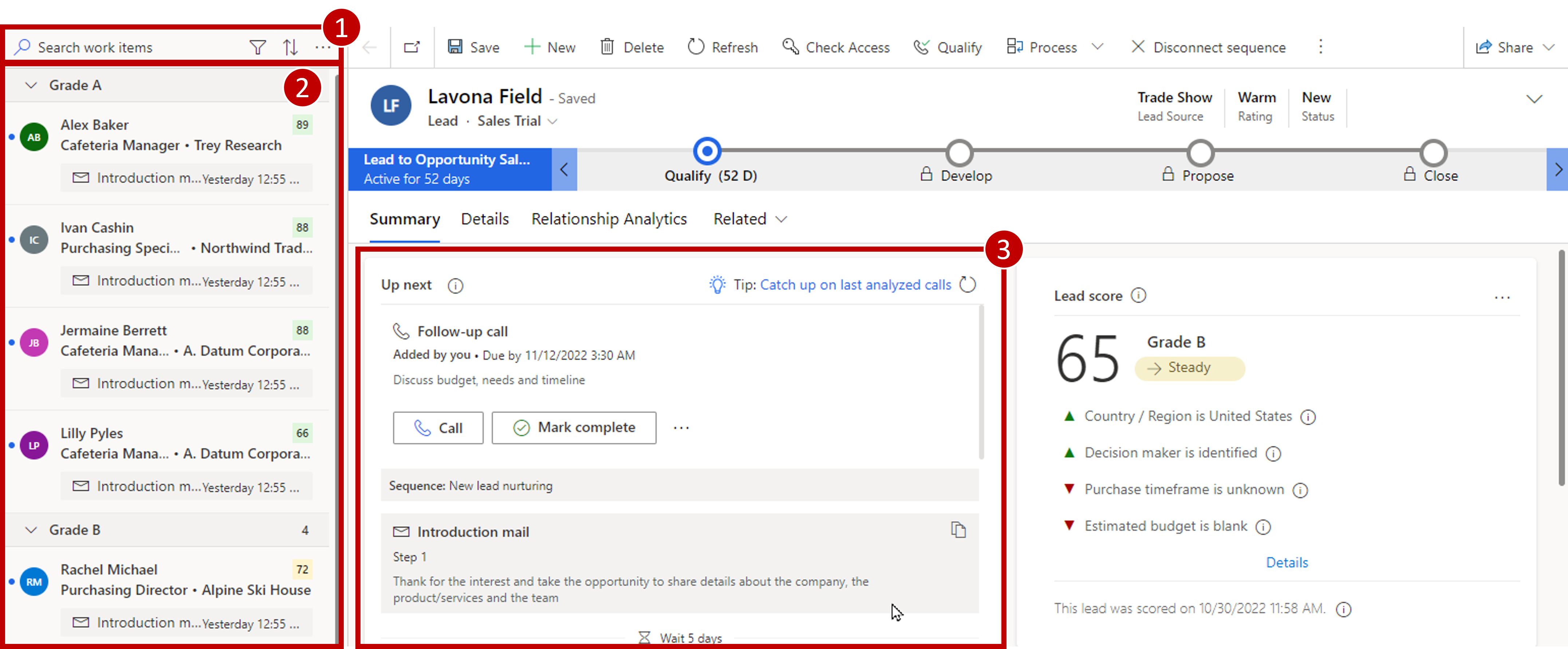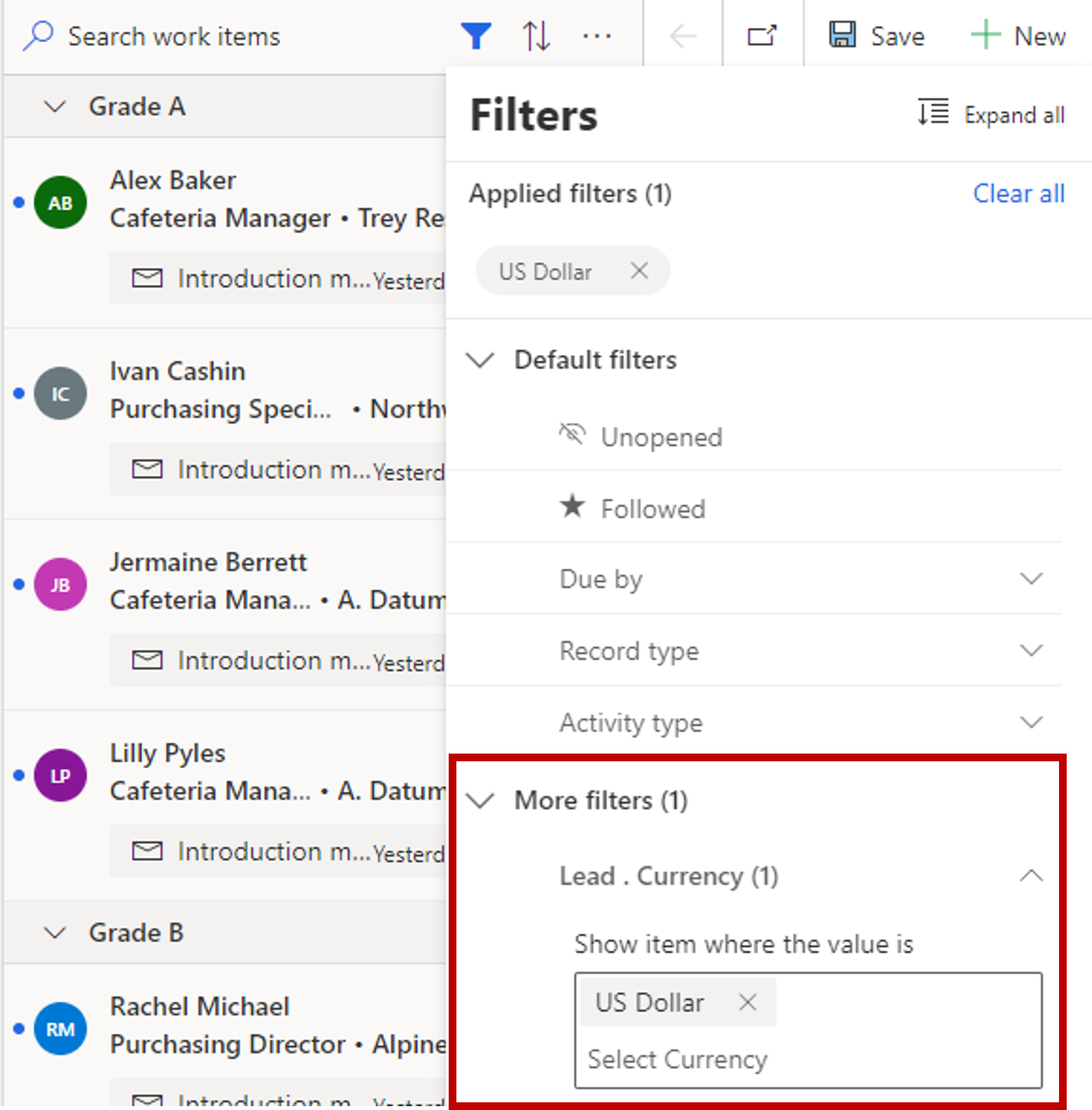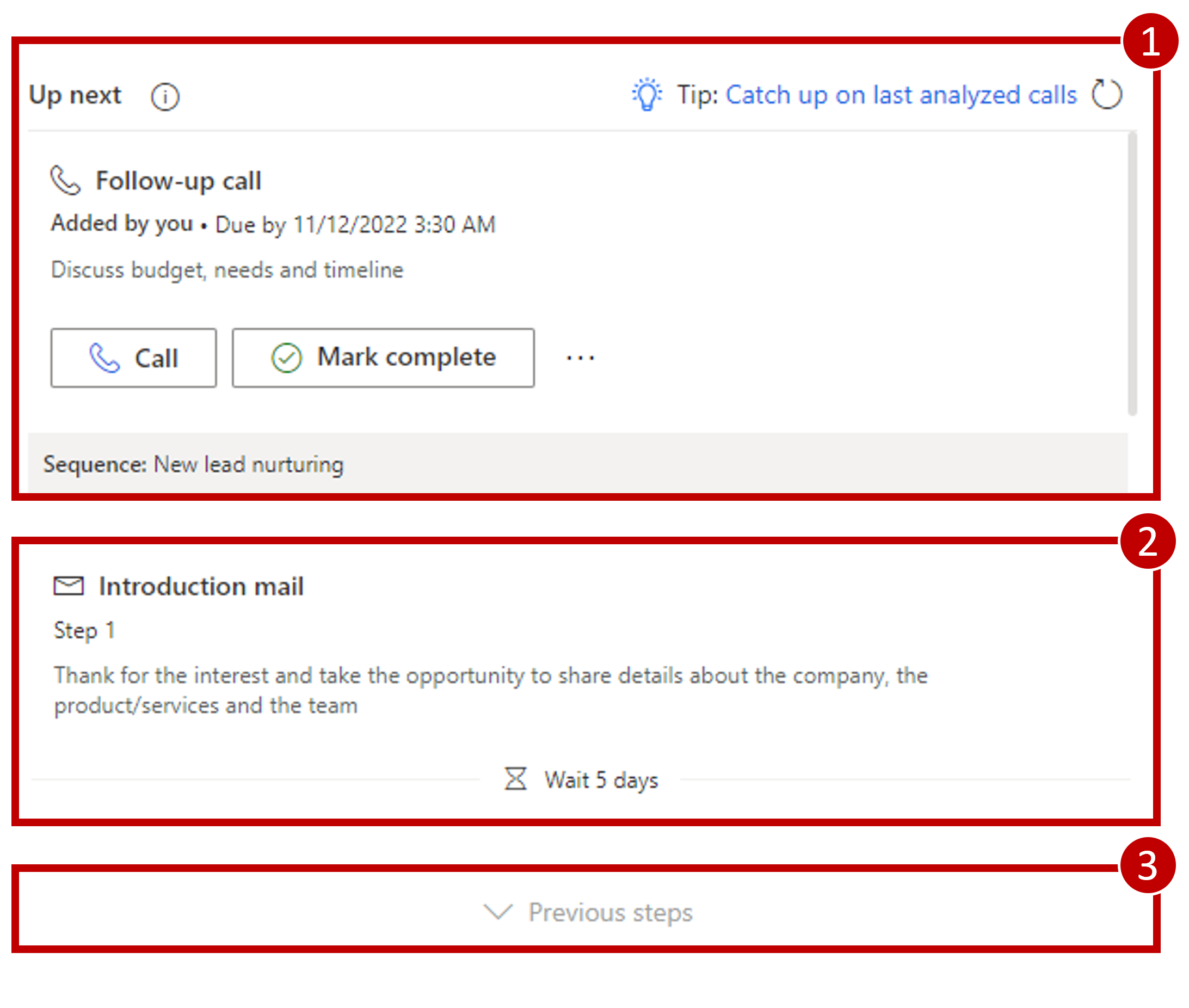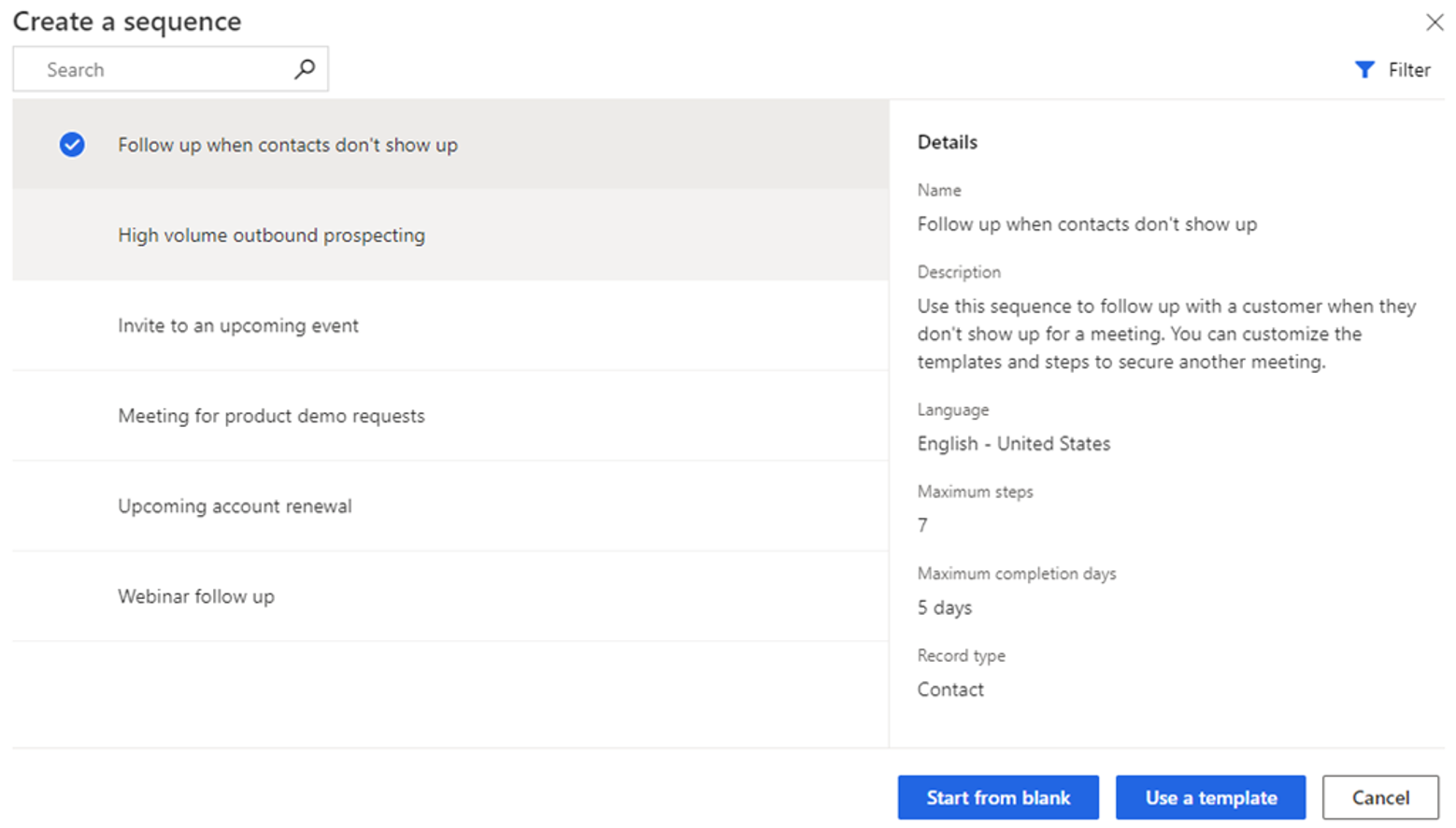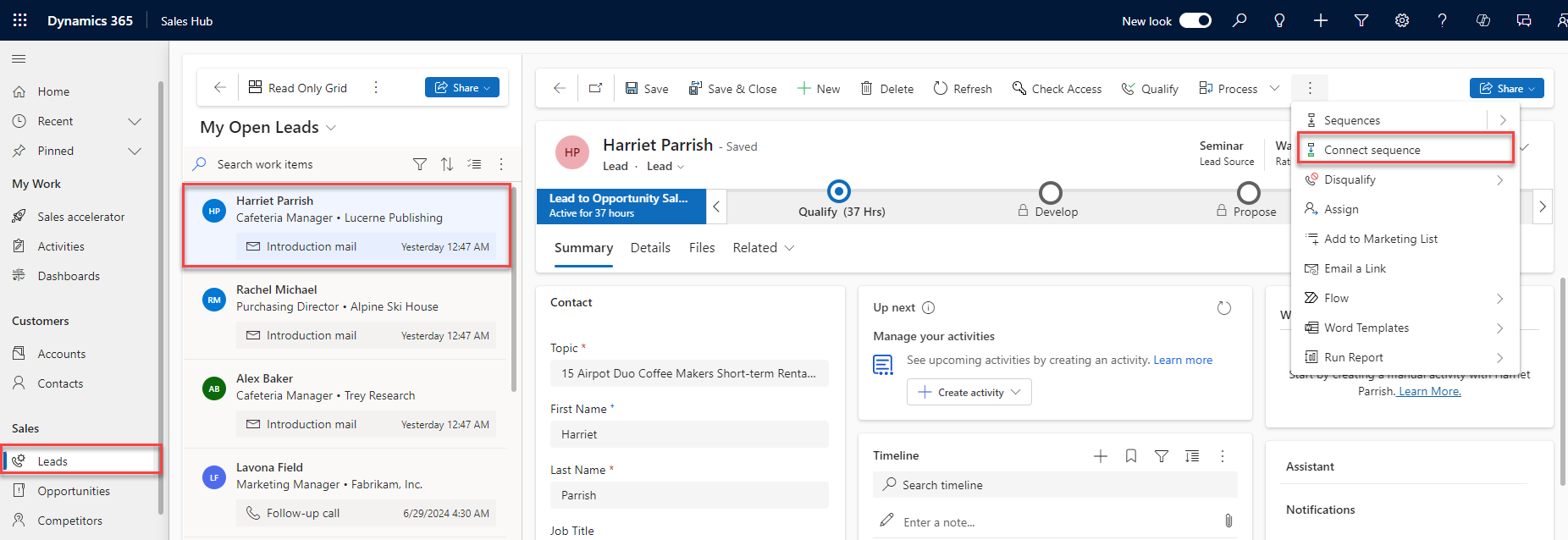Sales accelerator
It can be hard for sellers who manage many customers to make the most of their time and ensure that they're focusing on the right deals. Not only are they trying to manage their daily activities, but they're often spending valuable time identifying which customers to focus on in their customer list, and navigating across multiple sources to identify who they need to engage with, when, and how.
To overcome this challenge, the Sales accelerator in Dynamics 365 provides a tailored experience for sellers that minimizes the time spent searching for the best customer to reach out to next. It gathers information from multiple sources and lets sellers focus on how to best approach their customers. It helps sellers to sell smartly, by building a strong and prioritized pipeline, offering context, and surfacing automated recommendations throughout a sales sequence that helps to speed the sales process.
By default, sales accelerator is available in the Sales Hub app with limited functionalities. Sales teams can view their work list items created through timeline for contact, opportunity, lead, and account records, and can perform search, filter, and sort on the list.
The sales accelerator is an engagement platform that helps a sales team understand customers' needs and respond in the following ways:
Engage with customers by using multiple channels within one workspace.
Minimize the time spent on searching for the next best customer to reach out to.
Gather information from multiple sources and let sellers focus on how to best approach their customers.
Sell smartly by building a strong and prioritized pipeline, offering context, and surfacing automated recommendations throughout a sales sequence that helps to expedite the sales process.
Working with the Sales accelerator
The primary tool that sellers apply with Sales accelerator is the work list. You can access the work list by selecting Sales accelerator in the Sales Hub app. The work list displays a list of records that are assigned to you or the security role you're associated with. The records in the work list display activities that are due for the current date (or pending from previous dates.) These activities can be created manually or through a sequence (more on sequences later). This helps you to access all records that include activities in one place, instead of navigating across multiple forms in the application. A sales manager can configure and determine the entities to display to you in the work list. The top of the record in the work list is always the next-best customer with the highest prediction score.
This image shows an example of the work list.
Search, filter, sort, and group records: You can search, filter, sort, and group the records that you want to view in the list to quickly identify the customers to contact.
Records list: Displays a list of records that are assigned to you or to a security role that you're part of. The unread records appear in bold with a blue vertical bar on the left. You must perform and complete the activities on these records from the current date and from previous dates.
Up next widget: Displays the next best action that you can perform on a record for the given date.
Filter, sort, and more options
Filters help you prioritize the records in the work list so you can reach customers at the right time. The following image shows the list of options that are available to filter the work list.
Filters are categorized into two types:
Default filters
The following filters are available by default in the sales accelerator:
Unopened: View records that weren't opened or read.
Followed: View records that you're following.
Due by: Filter records according to the time that a task must be completed for a record. The following options are available:
Today: View records with pending tasks that weren't completed today.
From tomorrow: View records with pending tasks that are to be completed tomorrow.
Overdue: View records with pending tasks that weren't completed on time.
Record type: These filter options are the record types that the sales accelerator is configured for. You can select all options to view all records, or you can select an individual type to view only the records of that type.
Select at least one option to display relevant records in the work list. If no records match your selected type, an empty list is displayed. By default, all filter options are selected.
Activity type: These filter options are Phone calls, Email messages, Tasks, and Meetings. You can select all or any specific option to filter the records to display in the work list.
Select at least one option to display relevant records in the work list. If no records match your selected activity type, an empty list is displayed. By default, all filter options are selected. For example, when you select the entity type as Lead and the activity type as Call, the work list displays only the lead records that include call activities.
Custom filters
Custom filters are created specifically for you to view records that are important and relevant to you. You can contact your administrator to create a custom filter for you to use to filter records.
In the following example, an administrator created a filter based on lead and currency. You want to view leads that have currency set to US Dollar, so you choose the filter and select US Dollar as the currency.
Select Sort to organize records into groups and display them in the sort order you choose (ascending or descending).
Select More options to perform the following actions:
Refresh the list.
Send an email to multiple recipients at once.
Personalize your workspace. You can configure the following options:
Availability: Configure your work availability. For more information, see Configure your work availability.
Auto advance: Choose what happens next after you complete an activity. For more information, see Configure the auto advance steps.
Steps and activities: Create an activity automatically on the timeline that's linked to a step. For more information, see Configure steps and activities.
Filters: Hide or show filters from the available filter list. For more information, see Show or hide filters.
Work with records
Each record displays the name of the record, primary contact name, next best action, priority scoring, and entity name. Hover over the record to view more options.
Select More options to perform the following actions on the record:
Mark as complete.
Skip the current activity.
Snooze the activity.
Change the state of the record to unread or read.
Follow or unfollow the record.
Skip wait time (this option is available for items that are in the wait state).
Also, you can select the activity icon to perform the specified activity for the record.
When you complete an activity on the record, select the refresh icon. The list is refreshed, and the record is removed from the list.
The Up next widget
Once you select a record to work with from the work list, it's displayed in the application. Within the record, you'll see the Up next widget. This helps you view and perform actions on activities on a record. The widget displays the current activity, upcoming activity, and completed activities. You can add these activities to a record manually or by using a sequence:
In a sequence, a sales manager creates activities and applies them to the record according to business requirements. The activities in the sequence are displayed in the Up next widget.
For manual activities, you or a sales manager can create an activity on the timeline. The activity is displayed in the Up next widget as a current, upcoming, or completed activity, depending on its due date. This activity is available to you and other sellers who have access to the record.
The following image shows an example of the Up next widget.
Current activity: The current activity is a task that you must complete or skip to go to the next activity, which moves the record closer to completion. To perform an action such as making a phone call or sending an email, select the action icon displayed in the activity. For more information, see Connect with customers by using a record or the Up next widget.
After you complete the action, select Mark complete, and the activity is closed and moved automatically to completed items and is displayed on the timeline.
You can choose to skip the activity if you think it's not relevant to the record or you don't want to perform the action. Select More options, and then select Skip. The activity is skipped and moved to completed items.
Upcoming activity: The upcoming activity section is view-only, and you can't perform an action on these tasks. This section is displayed so you know which activity appears next when you complete the current activity.
Completed activities: These activities are marked as complete or skipped for a record.
To view the completed activities list, select Show completed. The section expands to display the list of completed activities with details such as whether the activity was completed (with date and time) or was it skipped. You can't perform any actions on these tasks; they're view-only. The following image is an example of an expanded section of completed items.
Work with sequences
One of the key elements in the Sales accelerator is sequences. Sequences help enforce best practices by introducing a set of consecutive activities for sellers to follow throughout their day. Records such as leads, opportunities, and accounts can connect to sequences to help prioritize activities that help you focus on selling, be more productive, and better align to your organization's business processes.
System administrators can create and manage organizational sequences. Any seller who is assigned the Salesperson security role can define their own sequences. When you create a personal sequence, you define a set of activities that you want to perform on records, and the order to perform them in. This lets you concentrate on selling and gives you a better understanding of what to do next. Any sequences created by an individual are available for your business unit. Other sellers can only view, connect, or create a copy of your sequence to build their own from.
Create sequences
The easiest way for individuals to create a sequence is to access the sequence designer in the Personal Settings page, under Sales accelerator > Sequence.
In the Create a sequence dialog, you can select one of the following options to create the sequence:
Use template: Sequence templates provide a set of activities to guide sellers with the next best action to take to achieve a task, such as getting introduced to a lead and winning the deal.
Start from blank: Use a blank sequence to create a sequence from scratch.
In the Define sequence properties dialog, enter the following information.
Sequence name: The name of the sequence.
Description: A description of the sequence (optional.)
Entity: The entity type to which you want to apply the sequence. By default, the lead entity type is selected.
Once you provide the necessary information about your sequence, you're taken to the sequence designer. By default, the Sequence starts here step is added to the sequence as the first step. After the Sequence starts here step, select Add (+), and configure the sequence steps.
Sequence steps are categorized into the following four groups:
Steps: A step in a sequence is an engagement task that a seller performs for sales outreach, such as sending an email (manual or automated), making a phone call, or completing a task. For more information, see Add steps to sequence.
Conditions: The condition step in a sequence determines the next course of action that the sequence will take after the condition is either met or not met, based on the completed activity. Examples of conditions include links being clicked, emails being opened, a reply and more. For more information, see Add condition steps to sequences.
Commands: The command step in a sequence determines the next course of action according to the value given in the field or stage of a business process. Examples of commands include advancing to another sequence or updating a field on a record. For more information, see Add command steps to sequences.
LinkedIn: The LinkedIn activity step in a sequence allows sellers to diversify their day-to-day activities by including social selling functions. You can use LinkedIn's vast network with recommended actions that your sellers can take to build deeper connections. For more information, see Add LinkedIn activities to sequence.
You construct your sequence based on what a logical flow would look like based on the end result you're hoping to achieve. For example, this screenshot displays an example of what a completed lead nurturing sequence might look like.
The Sequence begins with sending out an introduction email to the customer. Email templates can be added to the sequence step to prepopulate information for the seller as they create the email.
After the seller sends the email to the customer, the system waits for five days before moving on to the next step, which would be to send a reminder email to the customer.
The system waits another five days before the user is prompted to make a phone call to the customer to discuss options.
Five Days after the phone call is completed, the seller is prompted to send a thank you email to the customer.
Finally, five days after the thank you email is sent, they're prompted to schedule a meeting with the customer.
Once You sequence is complete, select the Activate button to make it live. You can have up to 250 active sequences at a time in your organization. Once active, you're now able to connect the active sequence to records.
While connecting a record to a sequence, you can create a new sequence if there are no sequences available for the record type, or the existing list doesn't meet your requirements.
Open the record type such as lead, contact, or opportunity, in the grid view for which you want to create the sequence. Select a record, and then select Connect sequence. In this example, we opened the Leads grid view to connect the sequence.
The Connect account to sequence dialog opens. If sequences are available for the record type, the list is displayed.
To learn more about how to create sequences, refer to Create sales sequences with Sales Accelerator.
To learn more about Sales Accelerator, see these links:
Salesperson:
Administrator:
